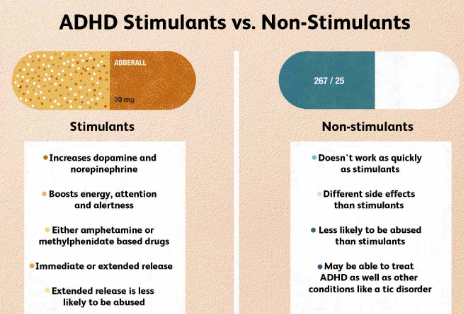PUBLIC HEALTH – Navigating the world of ADHD can be overwhelming, especially when it comes to treatment options. An ADHD medication list serves as a crucial resource for parents and individuals looking to understand the various medications available. In this guide, we’ll explore different types of medications, their benefits, potential side effects, and how to work with healthcare providers to find the best treatment plan.
Understanding ADHD and Its Treatment
What is ADHD?
Attention-Deficit/Hyperactivity Disorder (ADHD) is a neurodevelopmental disorder that affects both children and adults. Symptoms typically include inattention, hyperactivity, and impulsivity. While many individuals may display some level of these traits, ADHD significantly impacts daily functioning and quality of life.
The Role of Medication in ADHD Treatment
For many, medication is an essential part of an effective ADHD treatment plan. While behavioral therapy and lifestyle changes can help, medication often provides the support needed to manage symptoms. The ADHD medication list includes several types of drugs, each serving different needs and preferences.
Types of ADHD Medications
Stimulant Medications
Stimulant medications are the most commonly prescribed treatments for ADHD. They work by increasing the levels of certain neurotransmitters in the brain, enhancing focus and attention.
Common Stimulant Medications
- Methylphenidate:
- Brand Names: Ritalin, Concerta, Metadate
- Usage: Often prescribed for children and adults, it helps improve concentration and reduce impulsivity.
- Amphetamine-Based Medications:
- Brand Names: Adderall, Vyvanse, Dexedrine
- Usage: These medications are effective for many individuals and can provide longer-lasting effects.
Non-Stimulant Medications
While stimulants are the first-line treatment, non-stimulant options exist for those who may not tolerate stimulants well or prefer an alternative.
Common Non-Stimulant Medications
- Atomoxetine:
- Brand Name: Strattera
- Usage: This medication can be effective for children and adults. It works differently from stimulants and is often preferred when there are concerns about misuse.
- Guanfacine:
- Brand Names: Intuniv, Tenex
- Usage: Primarily used for children, guanfacine can help manage symptoms by affecting receptors in the brain.
- Clonidine:
- Brand Name: Kapvay
- Usage: Often used in combination with other medications, clonidine can help with hyperactivity and impulsive behavior.
Benefits of Using ADHD Medications
Improved Focus and Concentration
One of the primary benefits of the ADHD medication list is its ability to enhance focus. Many individuals experience improved attention spans, allowing them to complete tasks and engage in conversations more effectively.
Reduction in Impulsivity
Many ADHD medications help control impulsivity, leading to better decision-making and fewer disruptive behaviors. This can significantly improve relationships, both at home and in social settings.
Enhanced Quality of Life
When symptoms are managed effectively, individuals often report a better overall quality of life. They can participate more fully in school, work, and personal relationships, leading to increased satisfaction and fulfillment.
Potential Side Effects of ADHD Medications
Common Side Effects
Like any medication, ADHD treatments can come with side effects. Some of the most common include:
- Insomnia
- Decreased appetite
- Weight loss
- Increased anxiety or irritability
Serious Side Effects
While rare, some serious side effects may occur. These can include:
- Cardiovascular issues
- Mood swings
- Increased risk of substance misuse
Monitoring and Communication
It’s essential to monitor how your body responds to any medication. Regular check-ins with your healthcare provider can help address concerns and adjust dosages or medications as needed.
Creating an Effective Treatment Plan
Working with Healthcare Professionals
When starting a new medication, collaboration with healthcare providers is vital. Your doctor can help you navigate the ADHD medication list and find the best option based on your unique needs.
Consider Lifestyle Changes
In addition to medication, consider incorporating lifestyle changes to support ADHD management. These may include:
- Regular exercise
- A balanced diet
- Good sleep hygiene
- Mindfulness practices
Regular Follow-Ups
Set up regular follow-up appointments to assess the effectiveness of the medication. Discuss any side effects you experience and adjust the treatment plan accordingly. This ongoing communication ensures that you’re getting the best care possible.
Frequently Asked Questions About ADHD Medications
How Do I Know Which Medication is Right for Me?
Choosing the right medication often involves a trial-and-error process. Discuss your symptoms, lifestyle, and any concerns with your healthcare provider. They can recommend options from the ADHD medication list that may work best for you.
Can I Take Medication and Still Use Therapy?
Absolutely! Many people benefit from a combination of medication and therapy. Behavioral therapy can complement medication by providing strategies for managing symptoms.
Are ADHD Medications Addictive?
Stimulant medications have a potential for misuse, but when used as prescribed, they are generally safe. Non-stimulant options are also available for those concerned about addiction.
Conclusion
Navigating the ADHD medication list can feel overwhelming, but understanding your options makes a difference. From stimulants to non-stimulants, each medication plays a role in managing symptoms. By working closely with healthcare providers and considering a holistic approach, you can find an effective treatment plan that enhances your quality of life.
Final Thoughts
Managing ADHD is a journey, and medication can be a powerful tool in that journey. Stay informed, communicate openly with your healthcare provider, and remember that finding the right treatment takes time. With patience and perseverance, you can successfully manage ADHD and lead a fulfilling life
REFERENCE : https://boursessenegal.com/



